Blog 1st Feb
8th January 2024
So another year starts and the toilet is leaking again. It’s only salt water but needs attention. In fact I think I may have caused the problem by not knowing how to use a screwdriver properly; you would think at the age of 65 I would have got it by now, but no, there’s a special thing to do with self tapping screws in plastic that you have to turn the screw backwards first. Well you learn something every day.
Anyway all the best to you all for the new year and I hope you have a good one. It’s certainly going to be an interesting year in the USA and the UK and probably in many other parts of the world too.
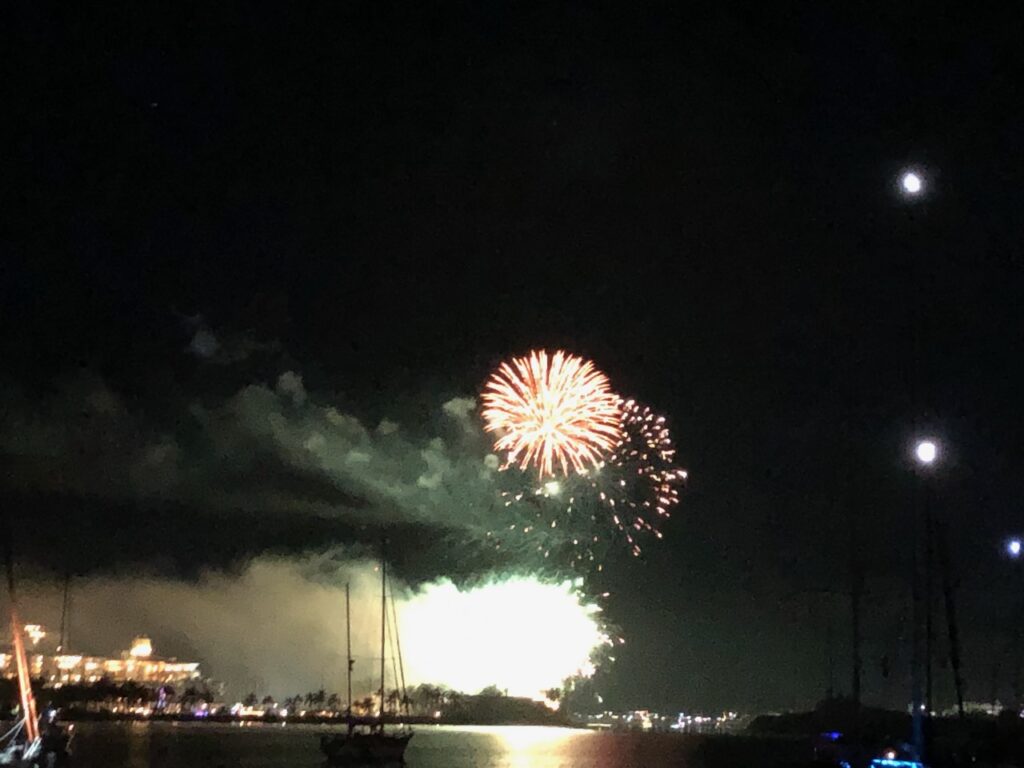
We arrived in Barra without any issues and I set about fixing the two main problems. Firstly the DC-DC charger that wasn’t working, on closer inspection I found a 60A fuse that looked in a bad way, it had a melted case and I assumed it had blown. This was the feed to the DC-DC. I presumed it blew because I had accidentally shorted the feed when I was swapping the DC inputs and outputs around, but on removing the fuse I found one of the nuts that clamp it down was loose, very loose. Either it had worked its way loose with vibration (unlikely) or I had never tightened it up properly (much more likely). With it being loose it might have generated a lot of heat. On checking the fuse, it hadn’t blown. I replaced it anyway, tightened it up, checked it was tight, asked my nurse to check again and then tested it out. It worked great, and charging was restored.
Next I looked at the water pump; it had stopped dripping. After running the engine for an hour, the area under the pump was damp, so I’m guessing the salt has built up around the hole and is reducing the water flow. As it’s belt driven, I’m going to leave it a bit before I attempt to change the seal. I’d like to buy some new seals anyway, so will probably do this job after we visit the next big city of Manzanillo.
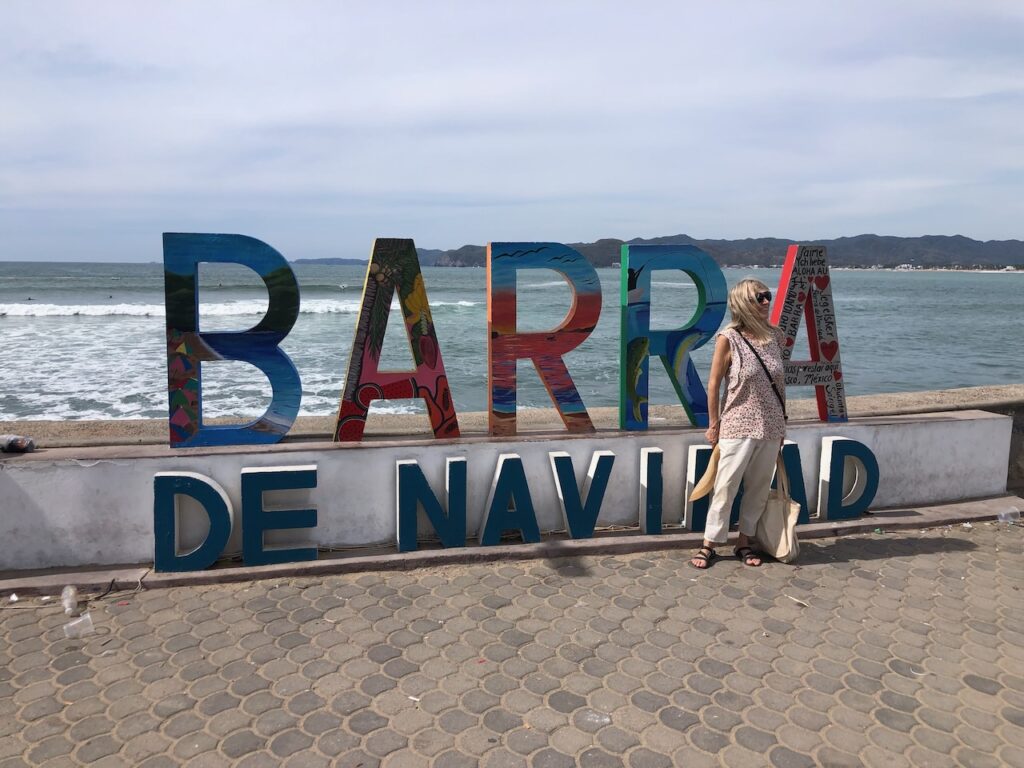
Barra is lovely, it has pretty much everything we need, fresh bread, 2 artisan bakers if needed, and a French baker who motors around the lagoon announcing on VHF Ch22 that he has baguette, croissants, cakes, wine, coffee etc for sale. There’s lots of fresh fruit and veg, a lovely street market every Thursday, where I bought a new hammock to replace the one the moths took a liking to. There’s also a water taxi that will take you from your boat to the town jetty for $6 return.
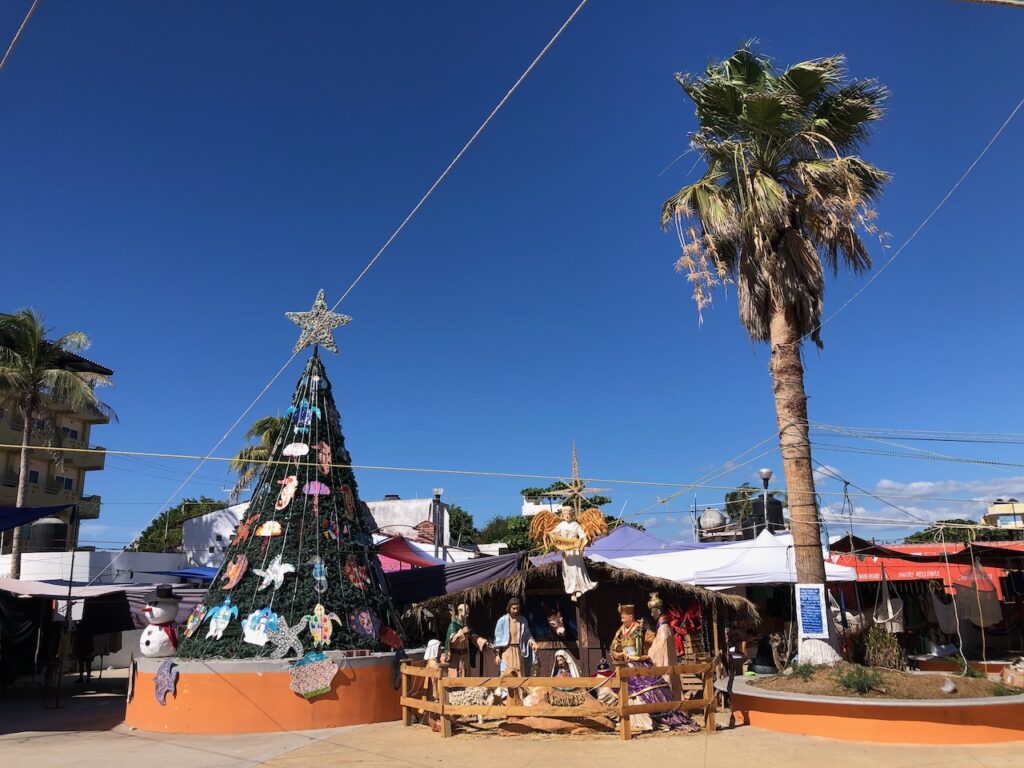
Every week we are also entertained as a new boat gets caught out by the sand bank on the way into the lagoon. As someone who has run aground more times than I care to admit, I won’t scoff
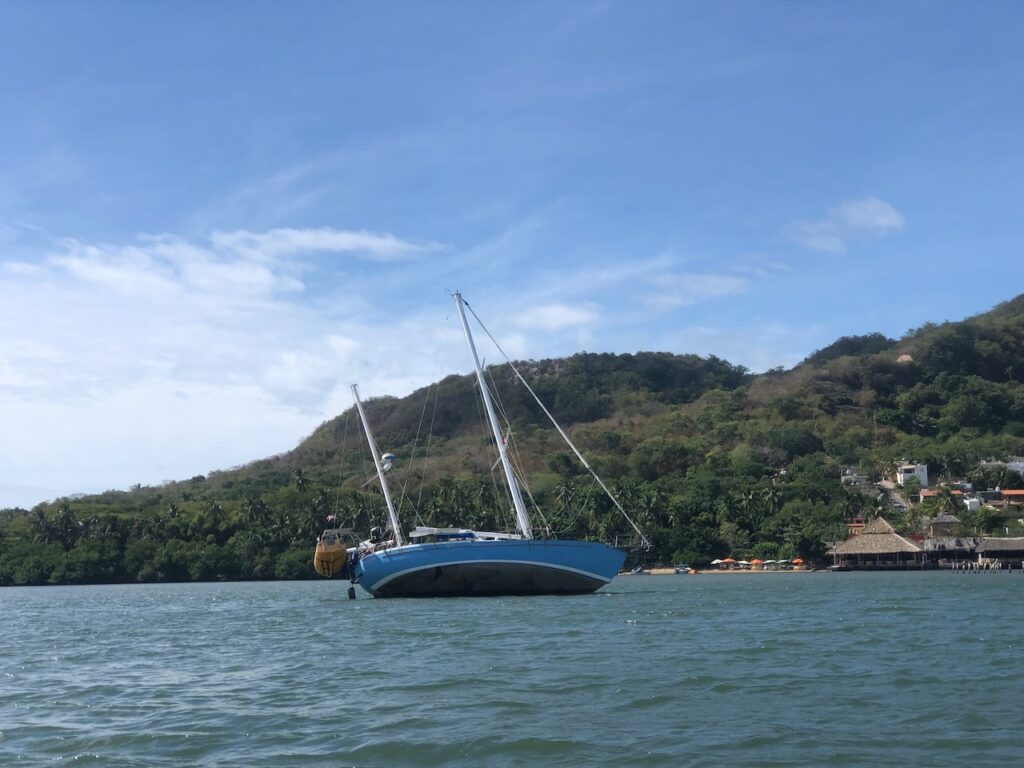
Last week we walked along the beach to the next, slightly bigger town of El Malaque. Lunch on the beach and a bit of shopping before we took the short taxi ride back.
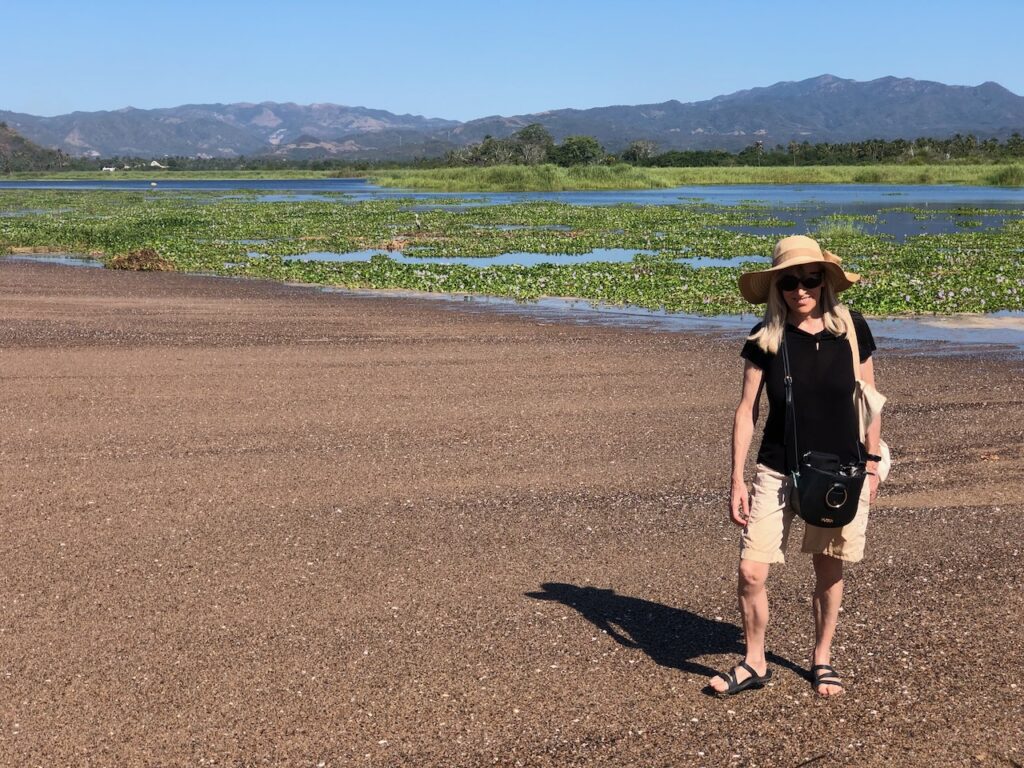
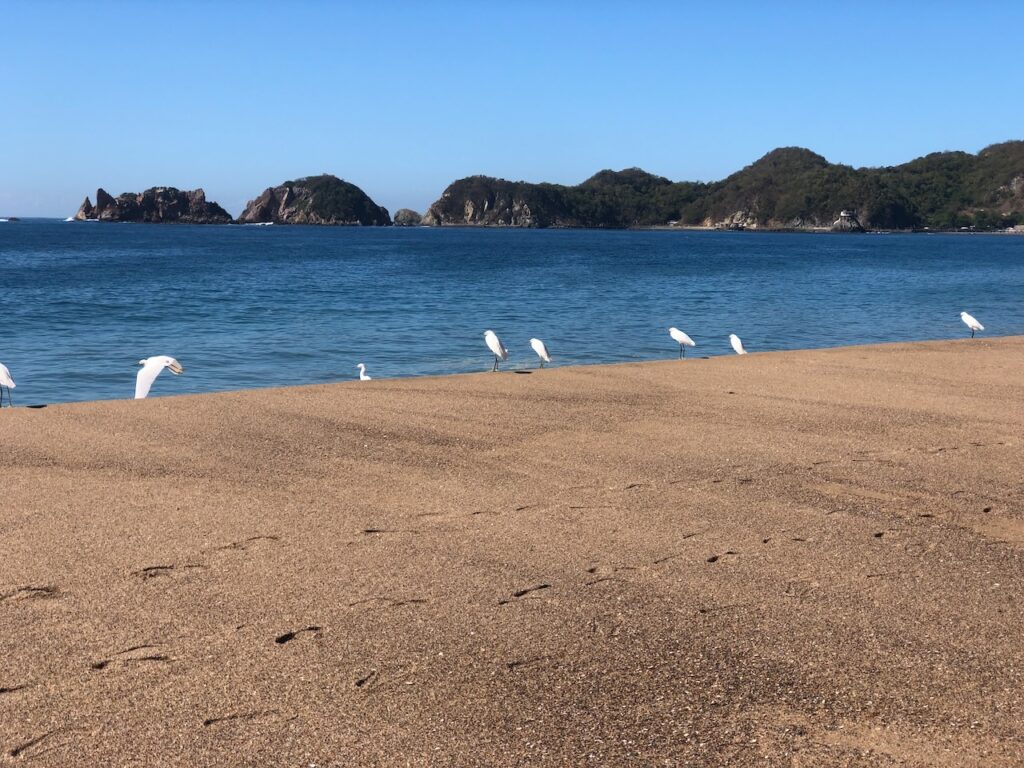
I have also tackled some of the other boat jobs. I’m currently fixing things at twice the rate they are breaking, which gives me some hope. The outboard engine has a problem with fuel leaking from the fuel cock (tap). Isaac brought me out a new tap and I finally got around to fitting it. Sadly it didn’t solve the problem. I bought a new tap in La Paz a few years ago, but ordered the wrong part. So far I have spent £100 on taps trying to fix this, and finally I realised it’s the rubber hose that connects the tap to the carburettor that is leaking. I can’t see how, but it appears to have become porous at the end. The hose has a specially preformed shape and I did try to order one, but they aren’t available, hence a google for ‘how to make pre-formed hoses’ had me thinking I could make my own. Unfortunately I don’t have any spare 6mm rubber hose on board but had a go with some PVC hose, I was really impressed at what can be achieved with some basic tools and the boat’s cooker. I managed to make a replacement part which not only bends in two dimensions, but three!. Unfortunately, that type of PVC isn’t really suitable for petrol, I’m sure it would work in a pinch, but I’m on the lookout now for some new rubber hose which I can practice on.
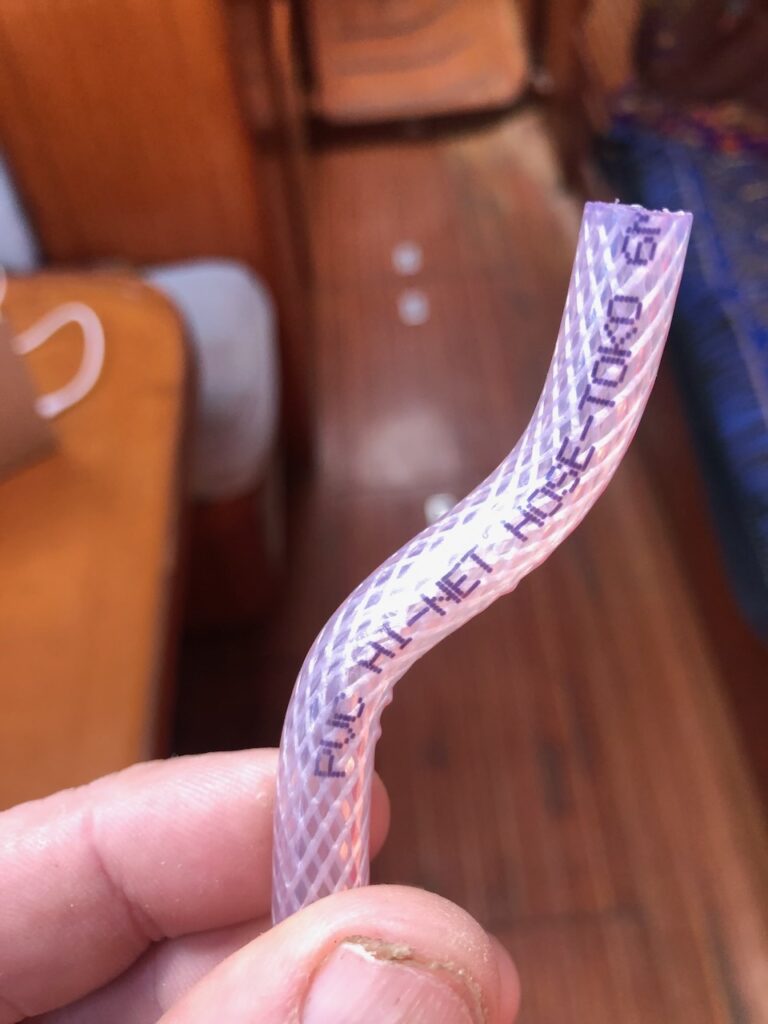
Now the boat seems to be in a reasonably good state, I’m turning to playing with the computers again. I brought out a new Raspberry PI 4 with me in October and I finally got it wired into the system. It is running a SignalK server and I’m going to try and get it talking to the BMSs on my new Lithium batteries and the Victron solar MPPT and Battery shunt using Bluetooth. I have never really done anything with bluetooth, but there’s bluetooth libraries for python that work on the PI operating system, so that should be fun.
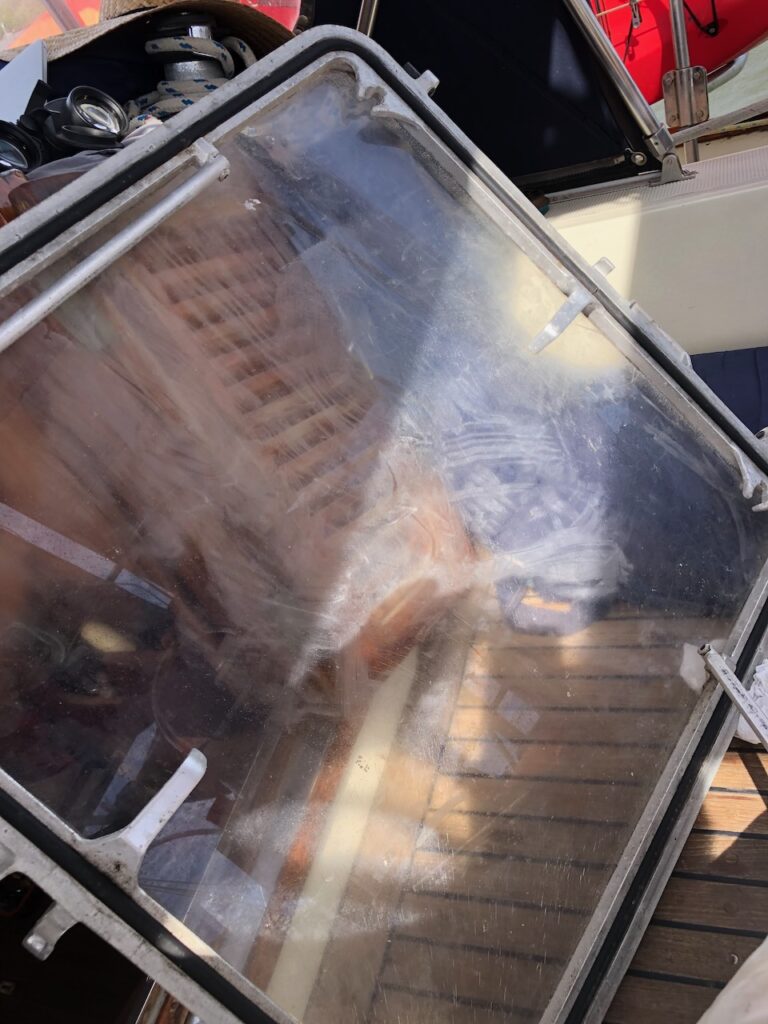
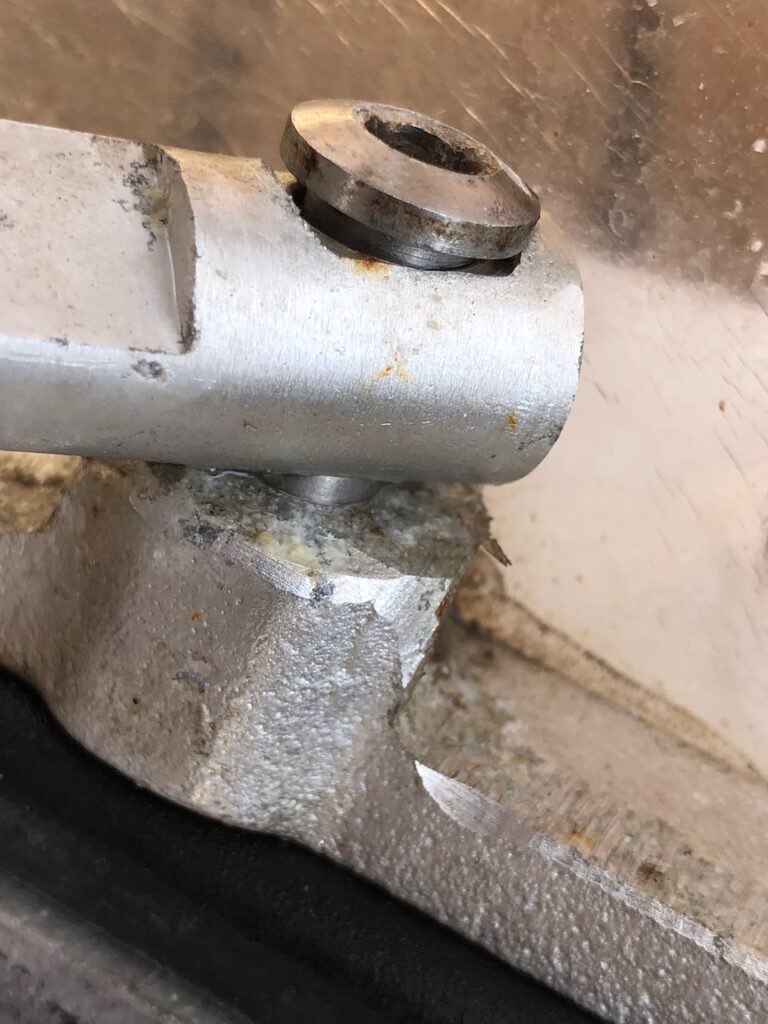
It’s not coming out, ever, especially now I rounded the Allen head
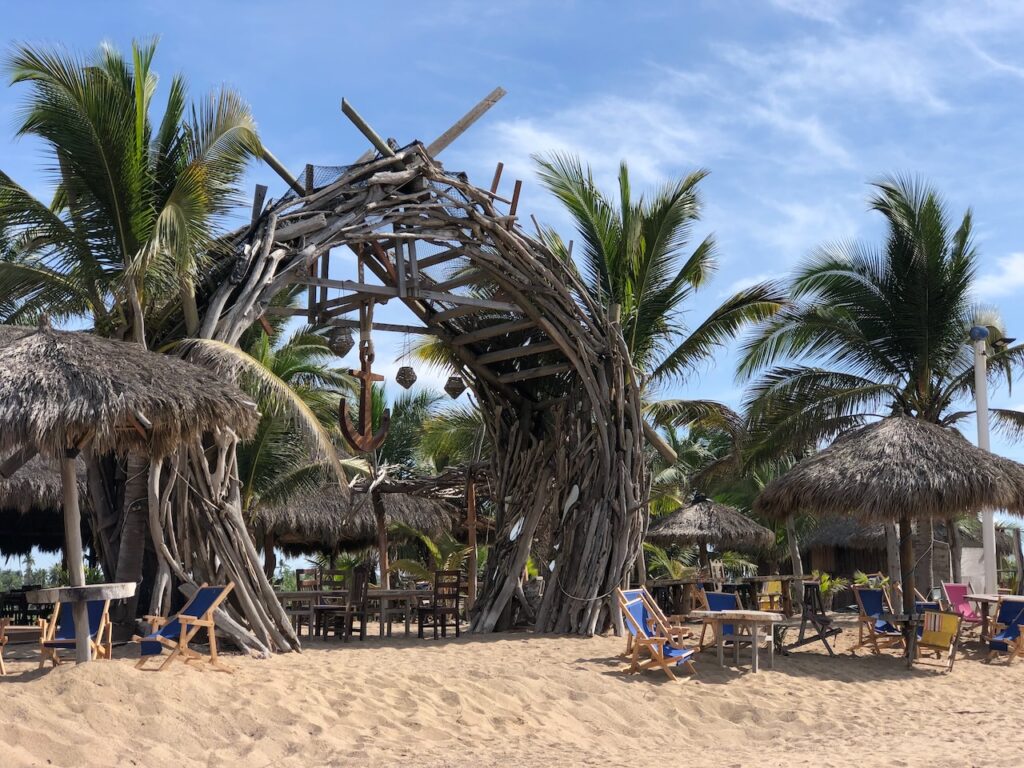
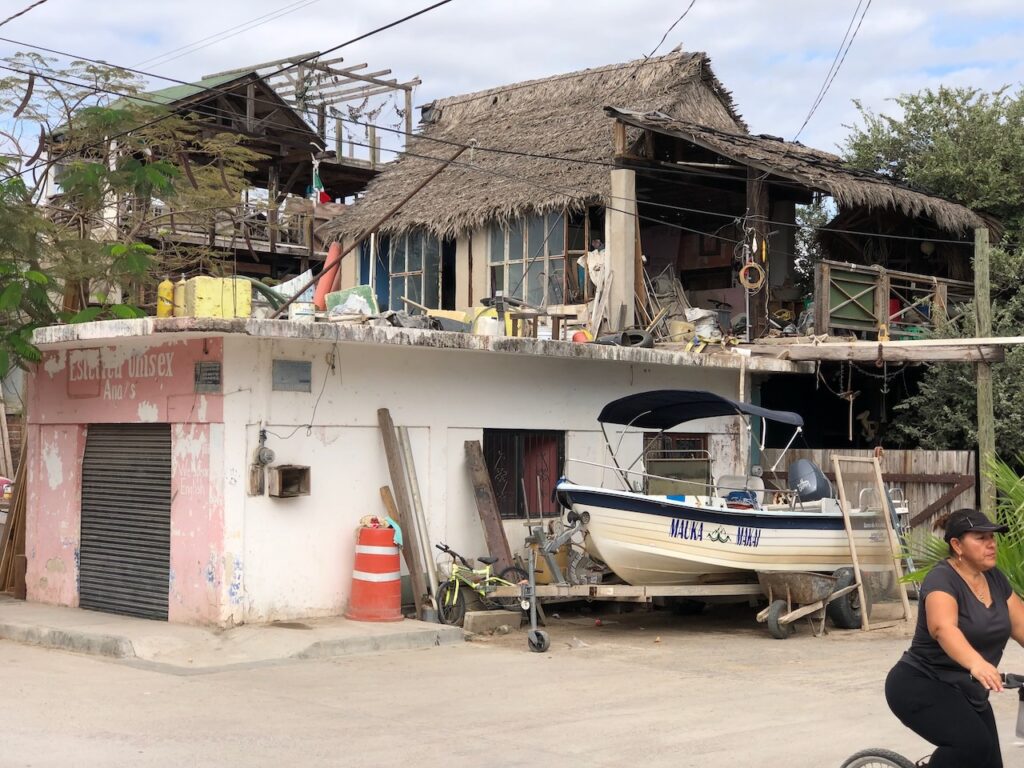
Friday 12th Jan.
We motored/sailed from Barra for 3 hours north to the bay at Tenacatita, mostly so I could swim under the boat and clean the prop and give some of the hull a clean. It’s also a lovely spot to chill. The DC-DC charger performed well on the way and the hull seemed not to slow us down much. On diving I found the prop to be very furry and quite a few barnacles taking hold on the hull, I’m a little disappointed with the antifoul and wonder if I will get two years out of this application. I caught a black skipjack tuna on the way here and I almost threw it back in as I don’t really like the taste, it’s a very dark, gamey meat type. I’m going to give it a try tonight as I hate wasting fish.
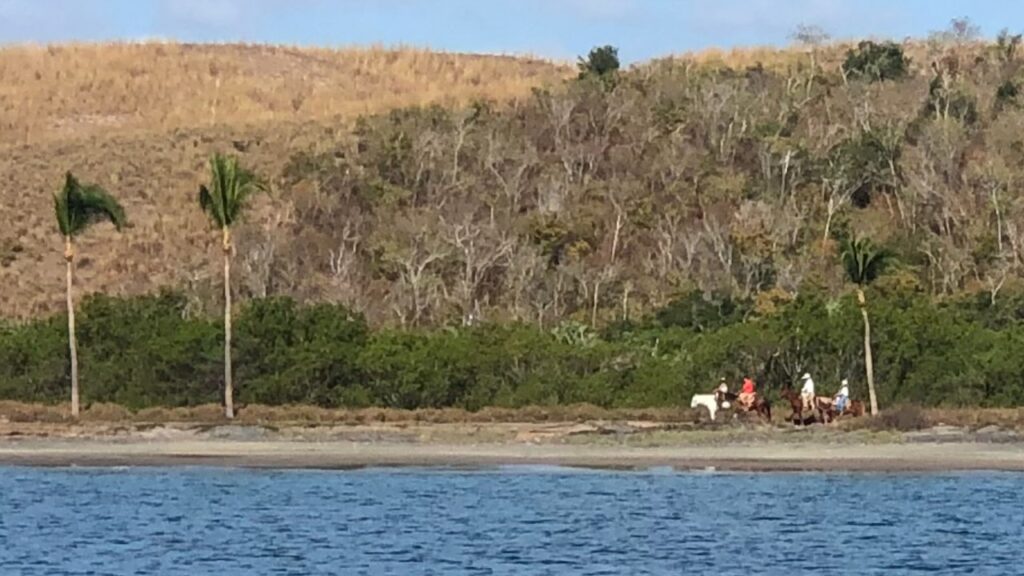
Monday morning and …
It’s Monday morning and time to leave the delights of Tenacatita and head back to Barra de Navidad for supplies, except ,when I start the engine there’s a terrible squealing noise. It sounds very much like a fan belt slipping so I immediately think alternator belt, I guess this goes back to my early days of car ownership, when this would be a common issue. I yank the engine box off and stare at the alternator belt running around, I’m wondering if there is anything I can do with the thing running to diagnose the problem, I’m thinking pushing the belt with a stick or some similar mad idea when I notice smoke coming from the back of the engine!. Crikey, this could be a fire, I leap into the cockpit and stop the engine. Jumping back down I’m refreshing my memory as to where the fire extinguishers are but realise there’s no need as the smoke is coming from the belt driving the raw water pump. Feeling around I see the pulley wheel (that can’t be the right name) on the end of the camshaft that drives the water pump belt is really hot, I soon deduce that the water pump is not turning freely and that the belt is slipping at the camshaft end, hence the smoke and heat.
So basically my previous idea that I could ignore the dripping from the water pump was a very bad idea. The sea water had got into the pump’s bearings and they were seizing up. Now I do have spare bearings and seals, I also have a spare pump, but it leaks as well, so I had options. Anyway the rest of the day was spent rebuilding the water pump.
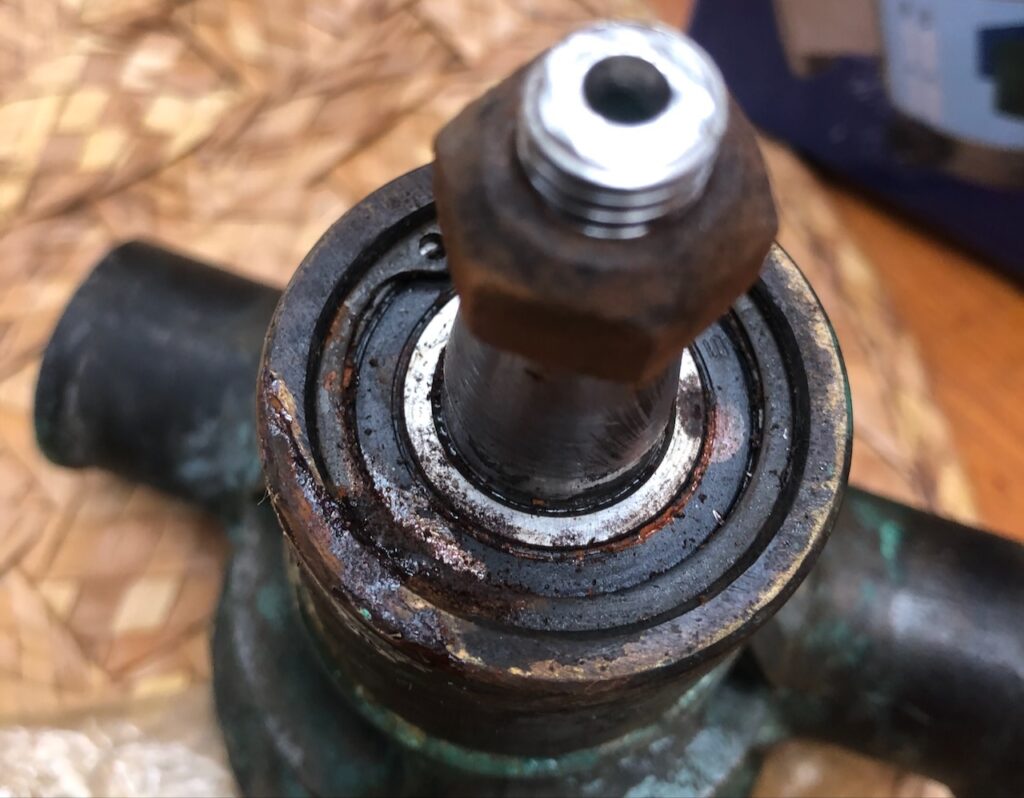
Firstly I had to disassemble the pump and that meant removing the shaft that sits between two bearings that are pressed in. The manual is clear, it is removed from the pulley end. I assumed that meant it travels away from the pulley end, wrong, it wouldn’t go the way I wanted and the puller tool I used managed to wreck the threaded end of the shaft making it unusable. I explained to Kathy that I’m just not a mechanical engineer, if I was any good at this I would have known that that amount of force on the puller was crazy, anyway I managed to get it apart eventually, cleaned it up, replaced the seal and bearings and put it all back together. I had to cut off half the threaded end as I had misshaped it so badly it was a millimetre wider than it should be and no nuts would go on. Once back on the engine I was feeling confident it should work but was very unhappy to find it was squirting out water worse than before. However it was pumping water around the engine and not making any fuss about it.
By now it was too late to leave for Barra as I didn’t want to arrive in the dark there, it’s not the easiest of anchorages with depths generally around 2-3 metres.
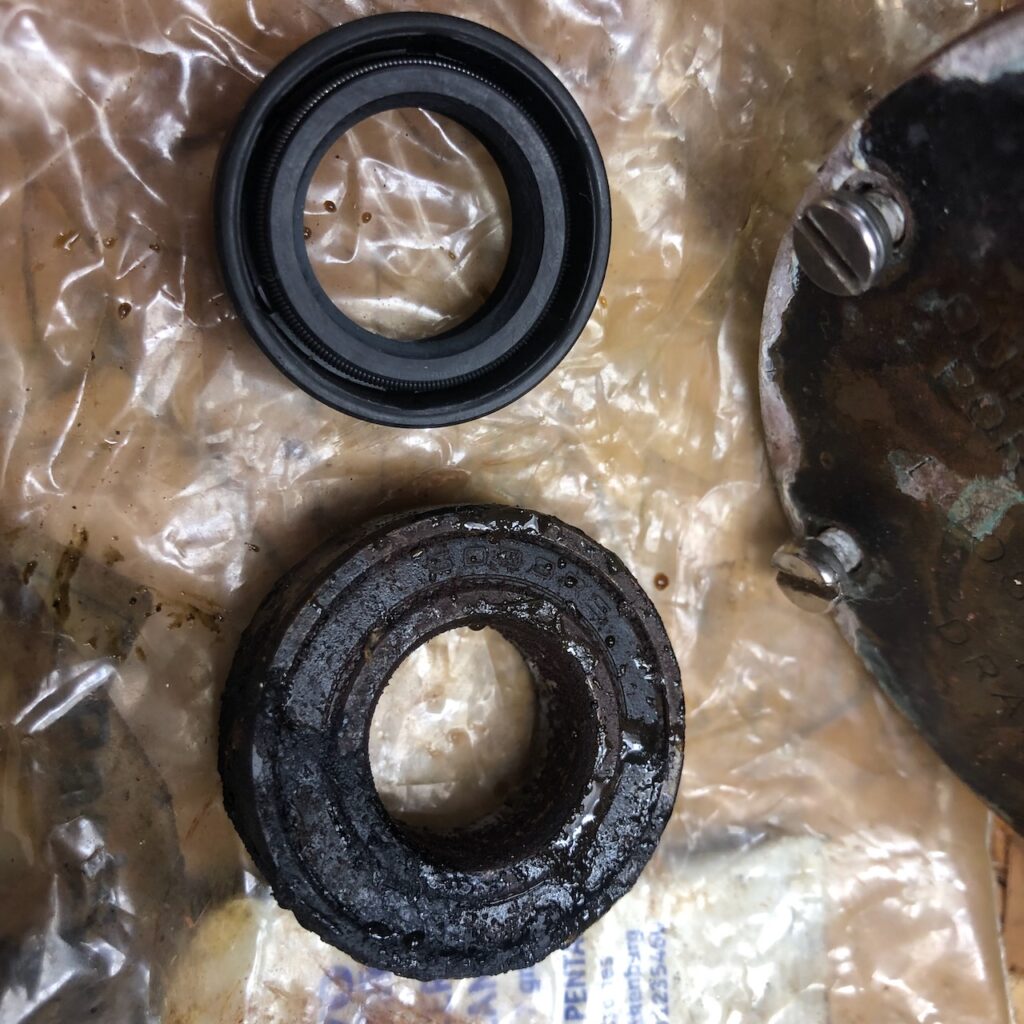
Tuesday 16th
We depart Tenacatita again, this time I have wrapped the area under the pump, including the starter motor, and the electrics box in tin foil and I have Primark’s (Uk version of Target for very cheap clothing) finest t-shirts stuffed into every crevice under the water pump to catch the leak. Every 15 minutes I swap the t-shirts for dry ones and all works out well. We anchor in Barra at lunchtime and find ourselves inbetween two other Baba 40’s , Greg and Kristen on Sonrisa, and Geoff on the famous Sailors Run. Geoff wrote a great book about his solo non stop sail around the world a few years ago in his Baba 40.
By now I have worked out that something is amiss with this water pump malarkey. The spare pump was rebuilt but leaked when I first tried it back in La Paz a couple of years ago. The engineer who rebuilt it said he wasn’t surprised as the shaft had a lot of wear. However I was confused then as it was quite a bad leak. Now this current pump was dribbling water out and slowly rusting the bearings, but with the new seal water was gushing out (slight exaggeration for dramatic effect). The first pump the engineer fixed had worked well, I had provided the seals and bearings, but the second pump he repaired, he had provided the seals and also bought extra seals for me, one of which I had just used. So off to the internet to research, and it’s very difficult to get details for the Volvo pump’s components. Volvo give them special numbers and special prices, the pumps are made by Jabsco, who very kindly also don’t give any details of the parts used for their pumps they supply to Volvo. However I eventually find a site that supplies seals for Volvo pumps which gives dimensions of 16mm for the inside seal that goes on the shaft. The seals the engineer gave me as spares, and presumably the one he used on the leaking pump are in fact 17mm. I’m excited and have concluded that the amount of water pissing out the seal is exactly 1mm’s worth. However the bearings are for a 17mm shaft, so perhaps that’s what led to the mistake on the seal purchases. So I have ordered a stack of 16mm seals and 17mm bearings and I will be chilling here in Barra until they arrive, hopefully next week. A pain in the arse that all these troubles may have been caused by a very simple mistake of 1mm a couple of years back, but an interesting exercise for me in mechanics. How these lip seals work is another mystery to me, it’s just a sliver of rubber on a rotating steel shaft. Somehow the rubber and the sea water must produce a lubricating surface, clever stuff me thinks.
I decided to do something I’m more capable of, mainly wiring up some sockets. Kathy remarked on how our devices, phones, kindles, iPads etc, are very much like tamagotchis, we seem to spend all our time running around feeding them electricity. and changing their charging cables for fear they might die.

I use my iPhone as the anchor position alarm, so hate it whenever it dies as I have to re-enter the anchor pos. So I added a few more power outlets, some USB, and a higher power charger (SAE) to drive the Starlink system.
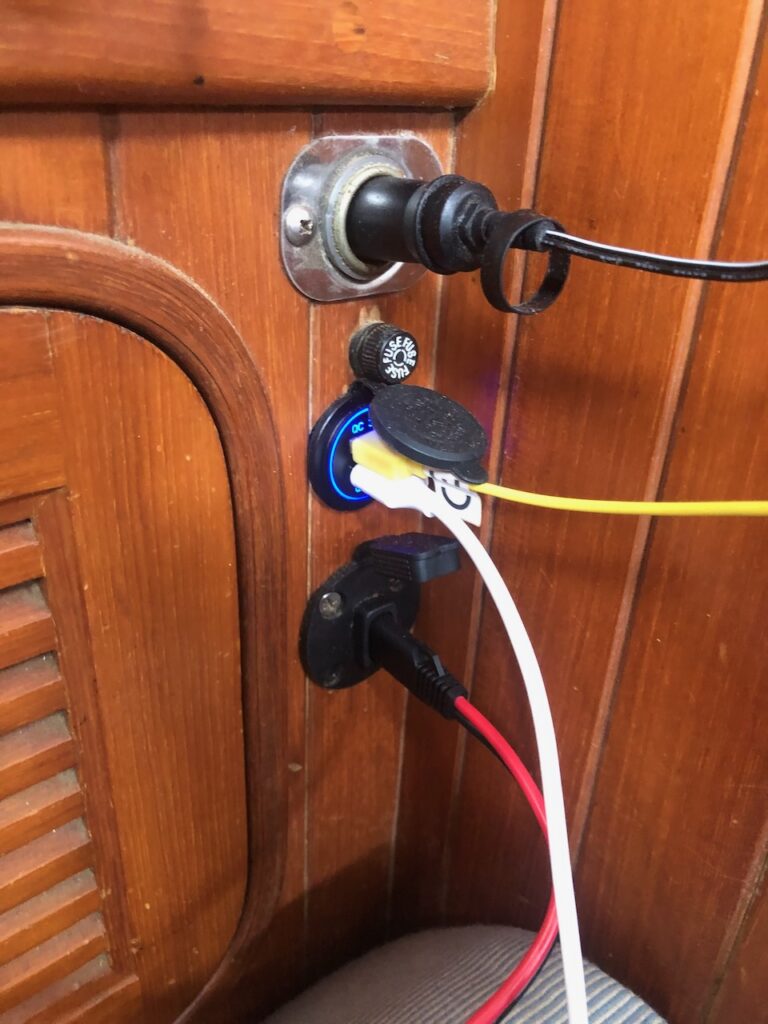
Part of this task required me to add some fuses. I took advantage of the time we now have to get Kathy with her eagle eyes to help me sort the fuses out, I find it very hard to read the values stamped on the end with my failing eyesight. between us, and with the help of a magnifying glass we got them all sorted.
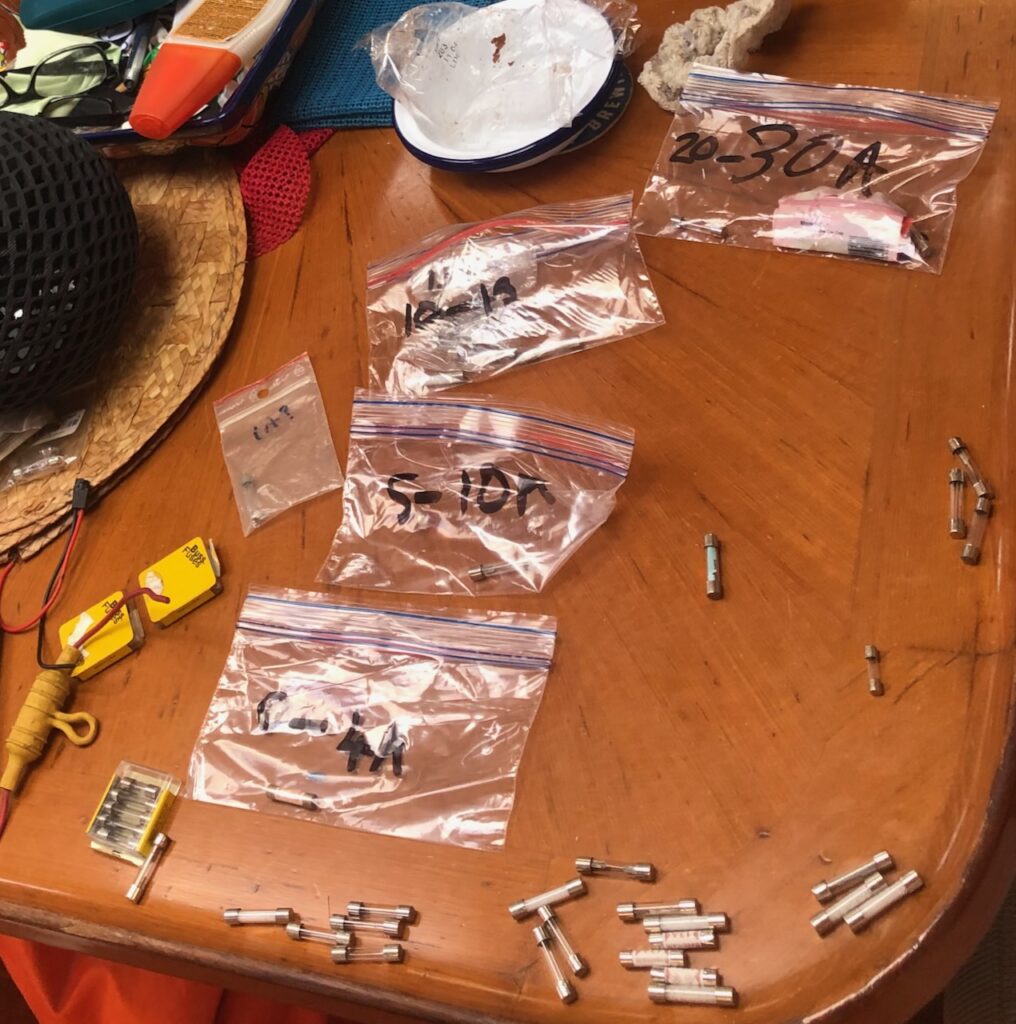
This really is the high life eh! at least it’s sunny here.
I ordered seals and bearings from a store in Manzanillo, but also ordered them online from a local ebay type supplier which quickly arrived at the marina.
I figured the seals and bearings at the ‘seals and bearings shop’ in Manzanillo might be a better quality, and as I have learned, you can never have too many seals and bearings, so I took a coach ride to town, to pick them up. It’s a one hour trip there and took me through some wonderful countryside including many banana farms, and a coir warehouse which had hundreds of thousands of coconut husks stacked up in fields ready for processing.
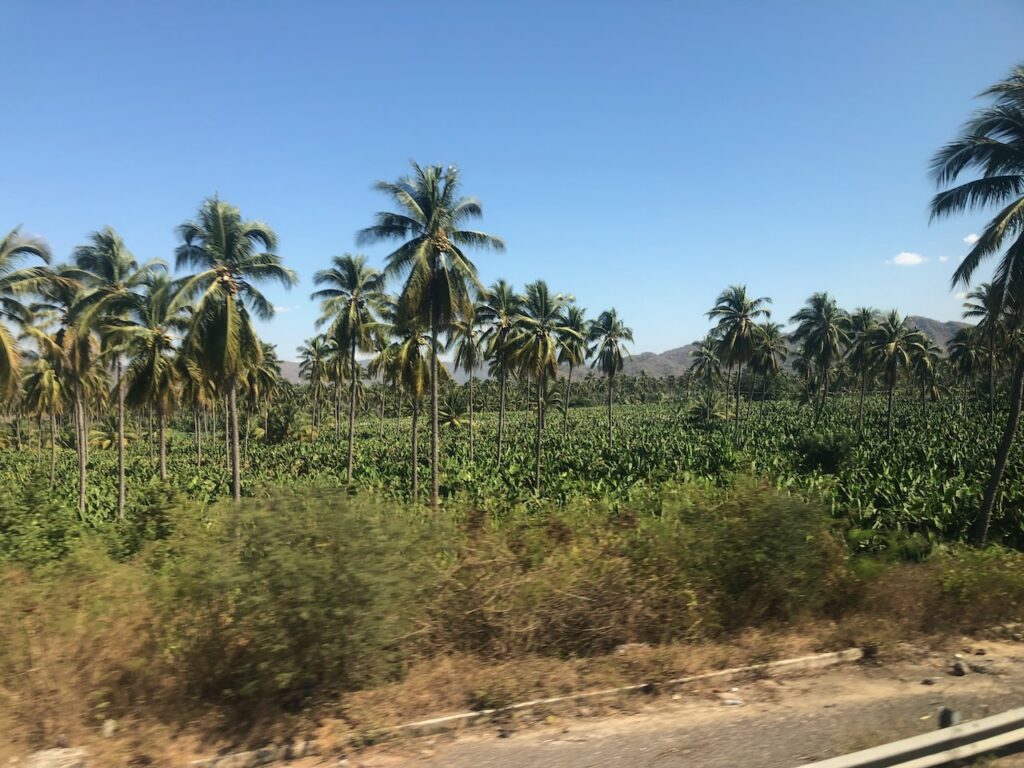
Back on the boat the foot operated salt water galley sink pump had started leaking again. I fixed this a few times, but the plastic casing has cracked as the screws rusted and expanded. If you pump slowly, it doesn’t leak much and only leaks when you pump (or so I thought).
The trip to Manzanillo went well except for the fact they wouldn’t let me on the bus home without providing photo-id, which I didn’t have. I explained that was a bit mean as they had been happy for me to take the same coach to the city. Was this a secret plot to repopulate the city I wondered. On production of the morning’s bus ticket they had sold me, they relented and said ‘just this once’ I would be allowed to travel without ID. I pondered for a while on this, and the best explanation I had was from Arturo, who thinks it is related to the large numbers of migrants arriving on the southern Guatemalan border heading north to the USA. I had hoped they were looking for gangsters, cartel members, or maybe international terrorists, but was disappointed they wanted to know I wasn’t an illegal migrant from Columbia or some other struggling country.
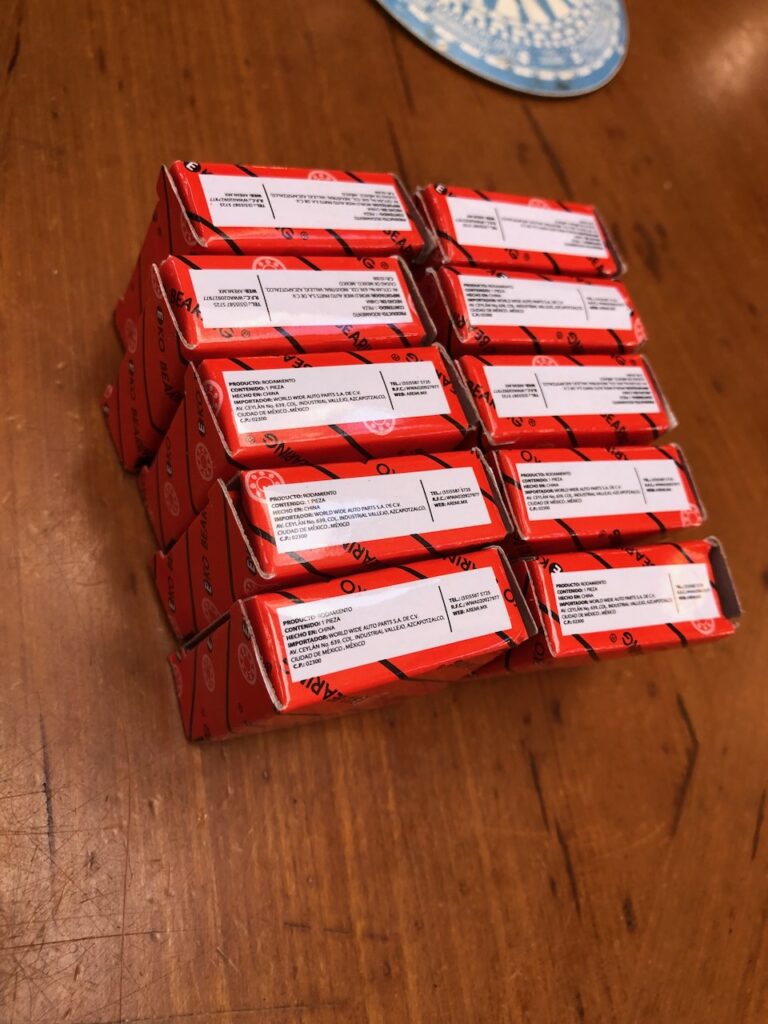
So with 14 bearings, and 14 seals I set about fixing the pump.

Putting the new 16mm seal in the current leaking pump solved that problem and the engine was up and running again. The shaft itself did not seem too badly damaged in the seal area.
Looking at the other repaired pump that leaked, I found that the engineer had in fact fitted the right seal and was correct that the leak was caused by excessive wear on the shaft. I’m hoping to find a workshop that can fix this, so I will have a spare.
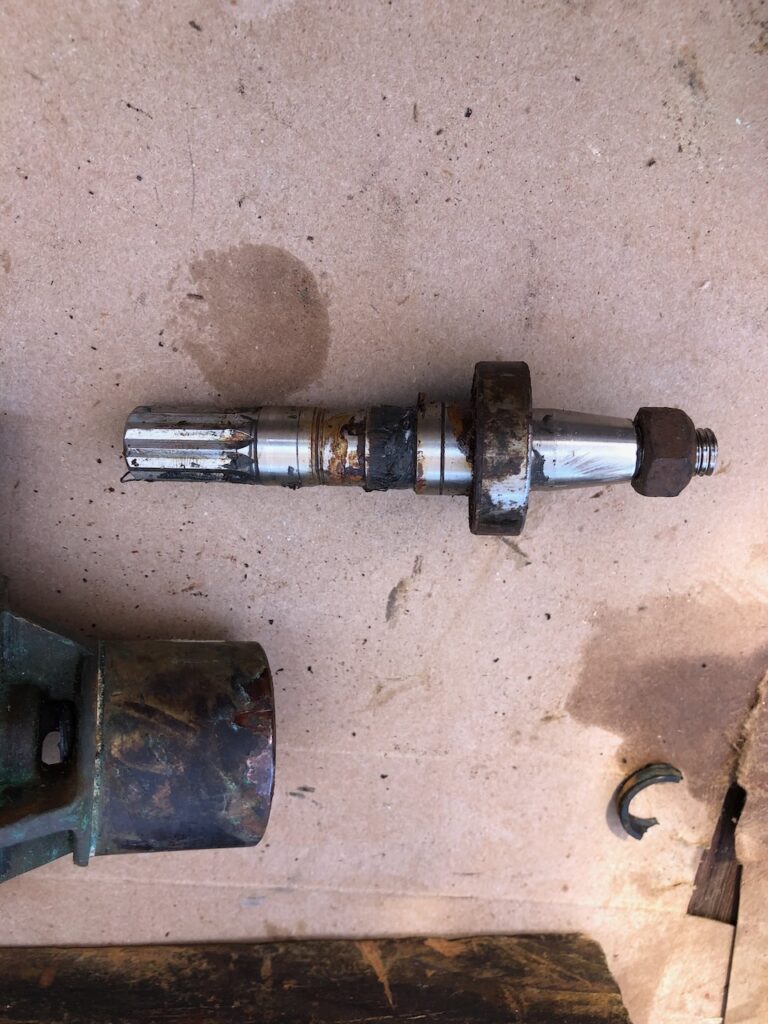
So with the engine back and the rest of the boat in decent shape we started to make plans to head south.
A sunset drink at one of the bars we walk past each time we go shopping was called for first.
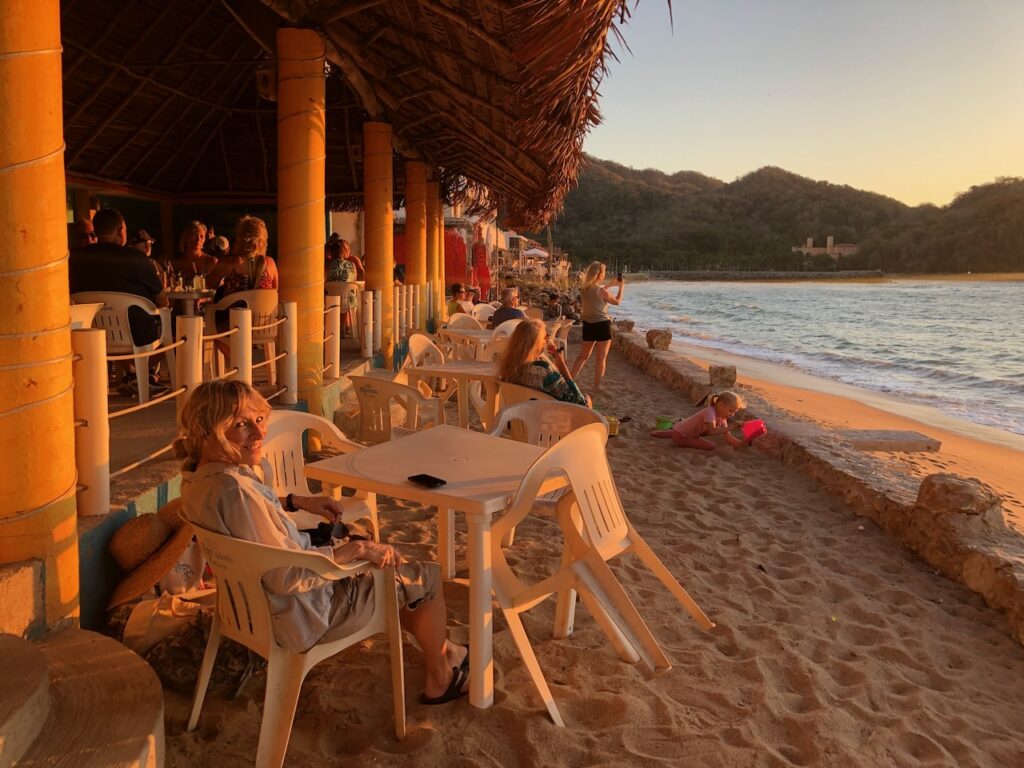
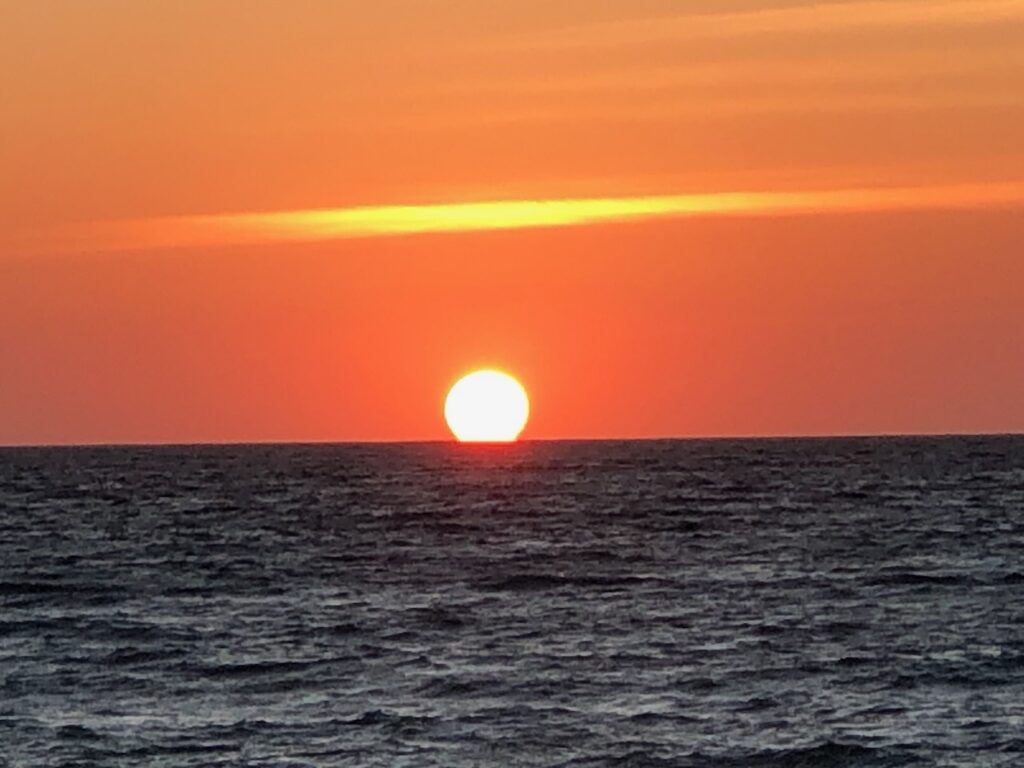
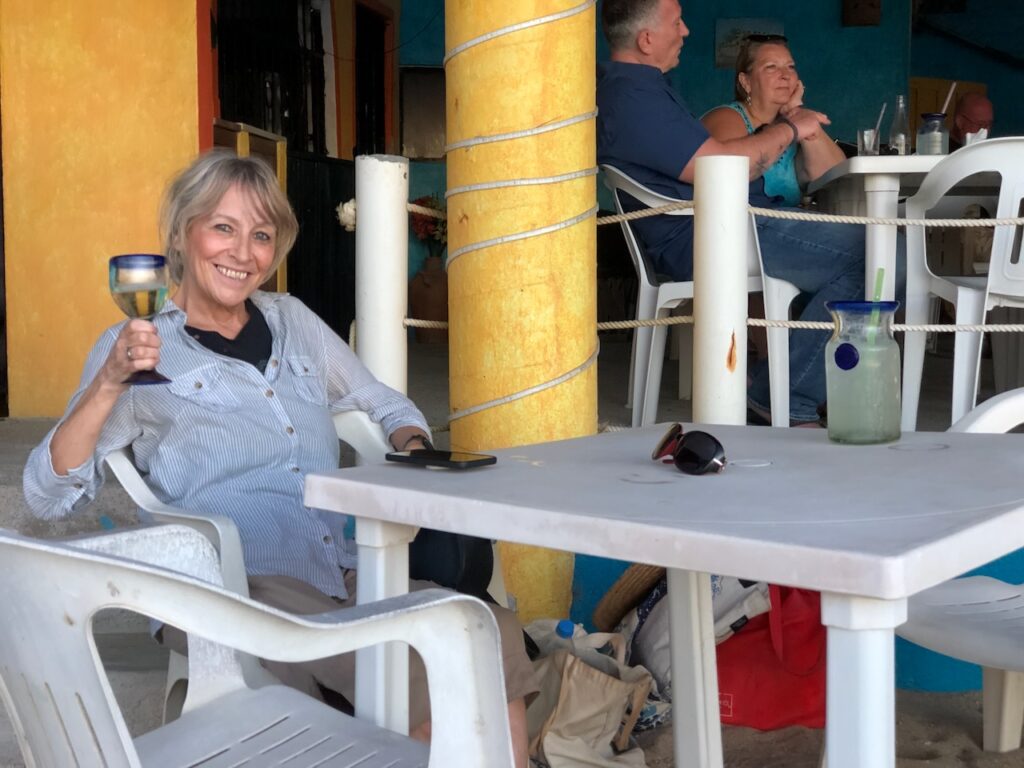
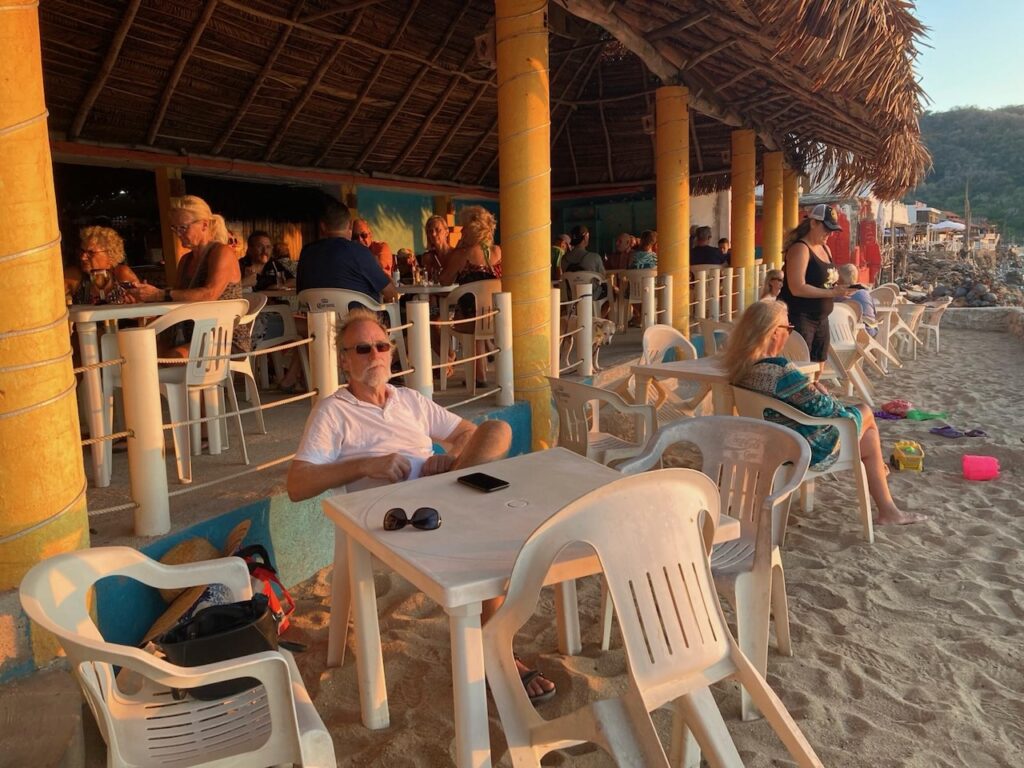
A couple of days before we left we were seeing quite strong afternoon winds, so much so that a green boat not far ahead of us started to drag. I spotted him as he came alongside the boat right next to us.
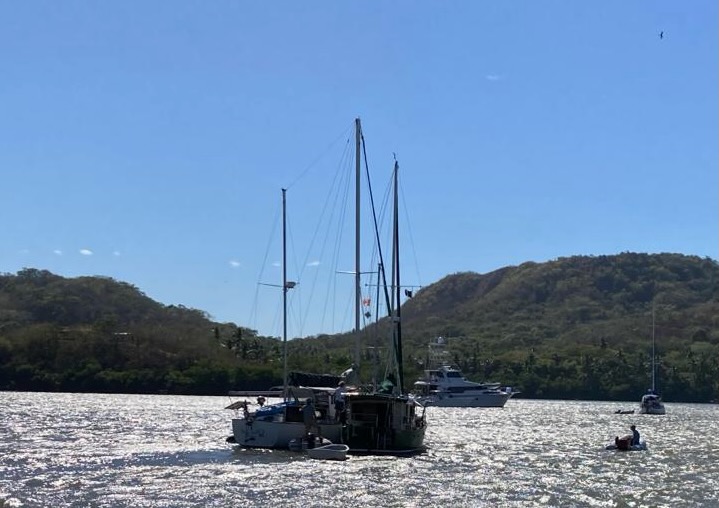
I hailed the boats on the VHF but it turned out they were both away. The green boat only had a very small amount of chain out and it eventually caught on the white boats anchor chain. This caused it to come to a stop perfectly alongside the white boat. After a bit of VHF chatter with other nearby boats we decided to head over and see what could be done. In the end we tied the boats together with a stack of fenders in between and laid a second anchor to try and pull them apart a little. Later I found the green boat owners number on the internet and called him. He was on a bus an hour away, but was quick to sort things out when he arrived. He had a few gouges on his cap rail but the white boat suffered no obvious damage. I watched the green boat try to re-anchor several times, but he couldn’t get his anchor to hold at all, not surprising given the small amount of scope he was laying out.
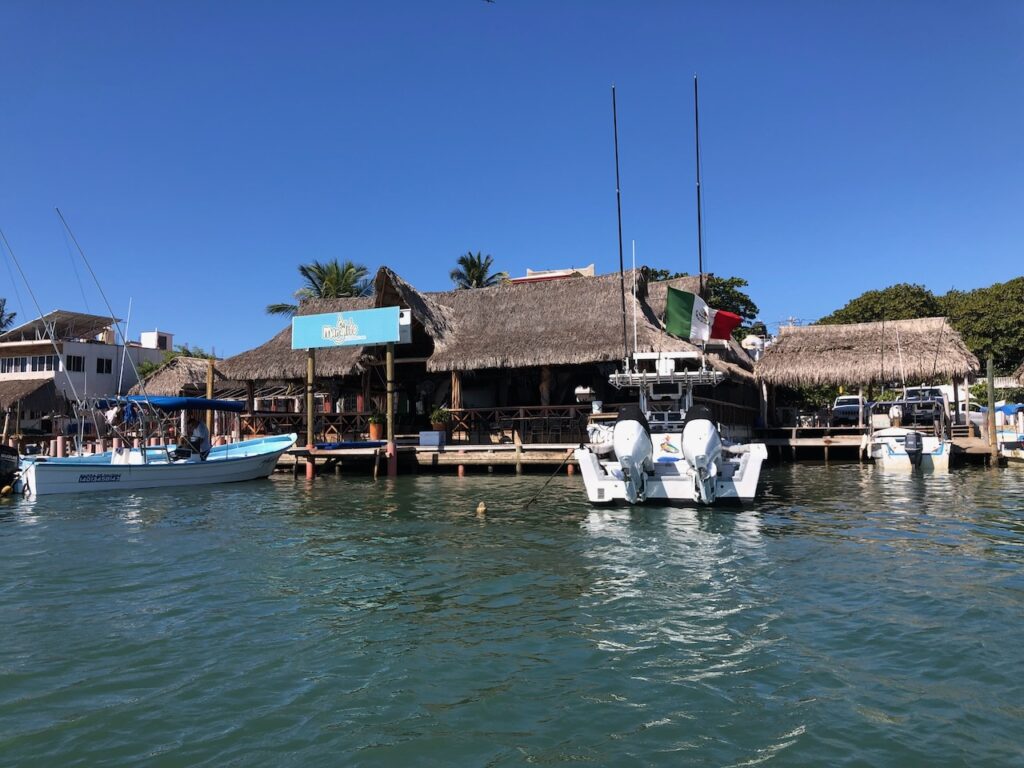
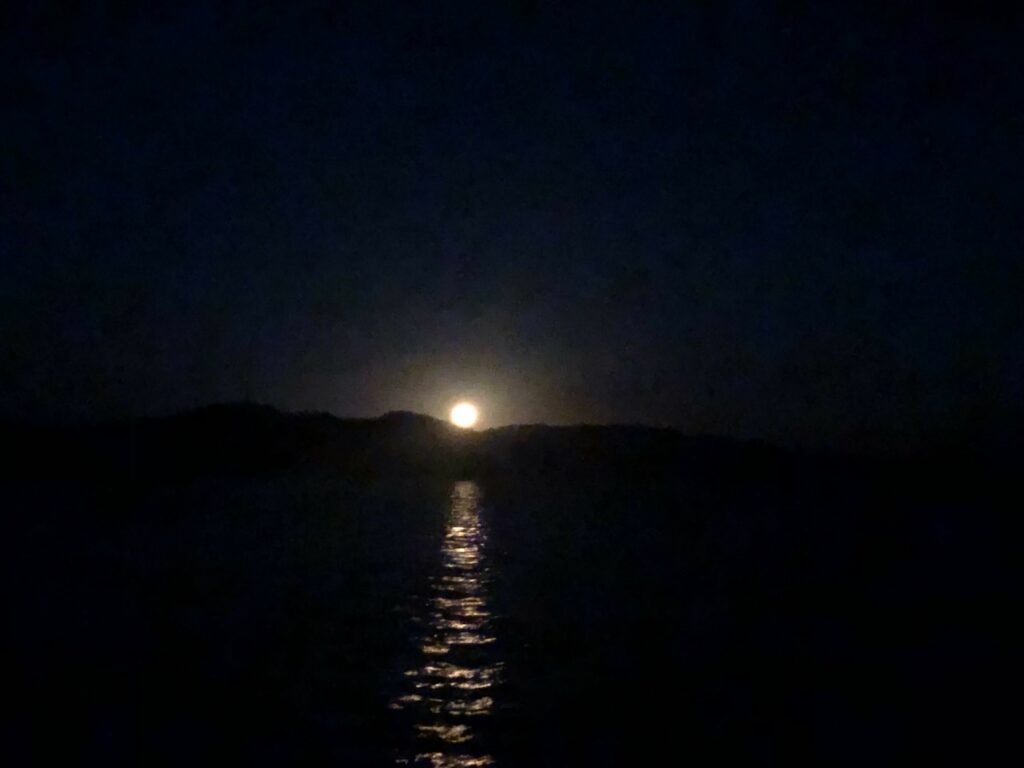
We took a bus ride to Cihautlán to provision for our next leg, and also just to see an inland town. A lovely spot with some great little shops.
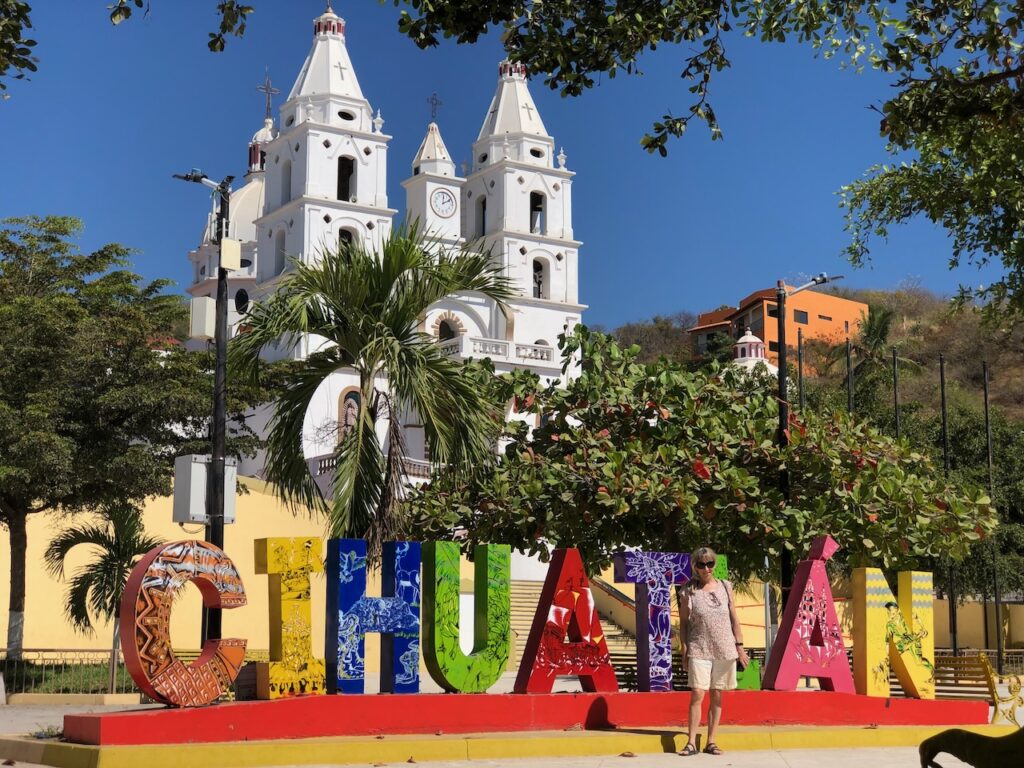
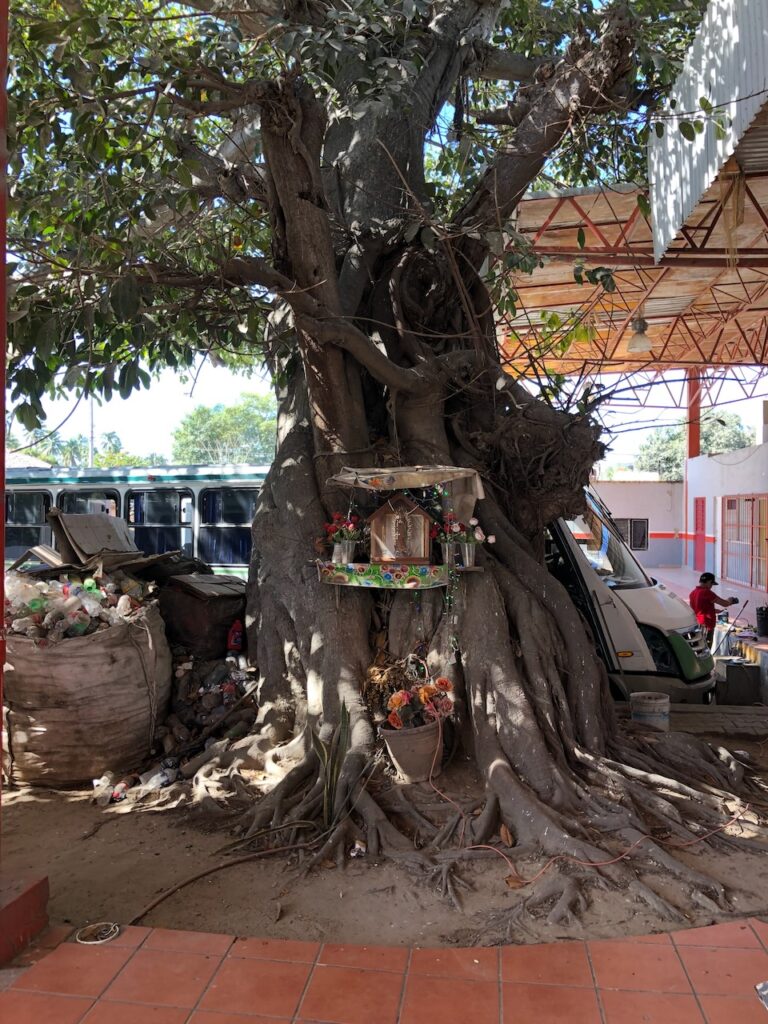
So with some extra food and drink on board we checked out at the port capitanias office and set sail for the little cove at Carrizal. Here I planned to do a bit of snorkelling and clean the hull as the water is lovely there. We motored out of the Lagoon with no wind at all, but once we cleared the harbour wall we picked up some wind and managed to sail the whole way. About half way, I had reason to look under the cabin sole (floorboards) and noticed they were full of water. I checked under the engine, and the water was very high. I mentioned to Kathy that we were sinking and she asked if I was joking, when I said no, she seemed a bit more concerned. She asked how bad out of ten, and I said I didn’t know yet, but it could be bad, but not to worry, we can see the shoreline.
Normally the automatic bilge pump turns on when water enters the bilge, this was now 3 foot under water and I couldn’t tell if was running and not keeping up, blocked or just not working. I had tested it before Christmas, but perhaps I should test it more often.
Next I powered up the emergency bilge pump and we waited to see if the level dropped. I had run around the boat pulling all the floor covers and couldn’t see any water rushing in, so was feeling a bit more relaxed. Within 30 seconds we could see the level had dropped and pretty soon the bilge was empty of water and I couldn’t see any more coming in.
So after a bit of head scratching I came to the conclusion the problem had been the sea water foot pump that had been leaking. The previous day I noticed some water underneath it, and given that neither Kathy or myself had used it in a day, I decided to turn of the seacock that supplies it. Up until that moment, I presume it had been filling the bilge up.
We arrived safely in Carrizal cove after a lovely gentle 5 hour sail. It’s quite rolly here, so I dinghied out and laid a stern anchor. This pulls the boat so we are pointing into the waves. this makes the boat rock up and down lengthways, and is much much better than the nausea inducing sideways rolling the swell can create.
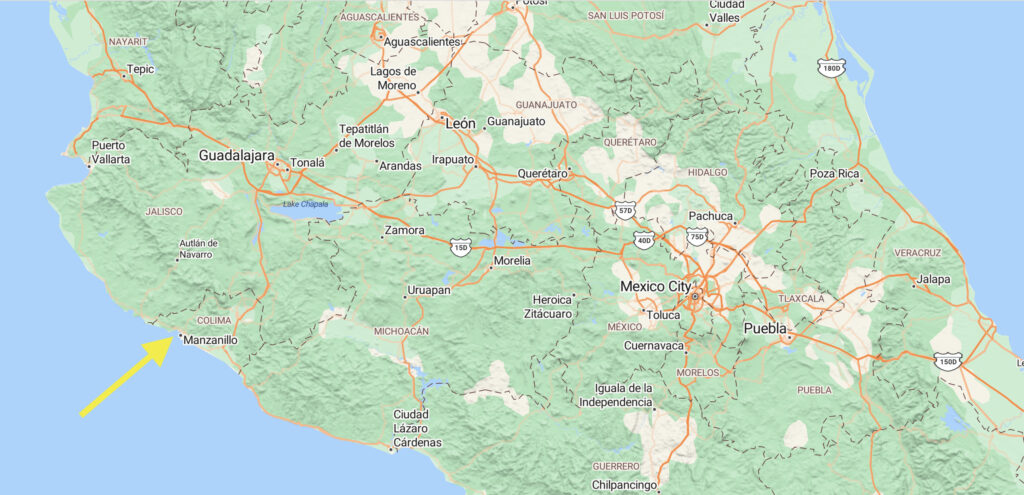
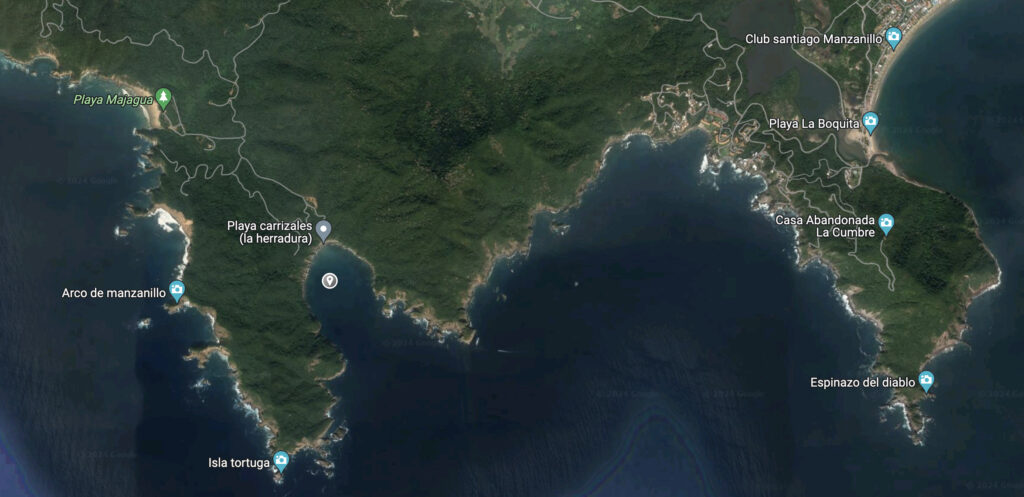
Thursday 1st Feb 2024: Water Water Everywhere
We wake to a lovely morning in Carrizal, however the fresh coffee tastes a little salty. Since the salt water tap is out of action, I rigged up a large bucket of sea water on the stern for cleaning dishes, and Kathy suspects thats the problem. So I dispose of a cafetière of expensive coffee and start again, same problem. I pour a cup of fresh water from the tap and drink some, yuk, it’s salty.
So the fresh water tank has sea water in it. This is annoying, as I paid good money for maybe 8, 20ltr garrafons and carried them from the shore to fill up that tank, and the whole lot are wasted now. Further checking and the starboard tank is good. For comparison, the starboard tank has a reading of 20 parts per million of salts, and the port tank 3500 parts per million. Sea water has over 35000 ppm so the tank has about 10% salt water in it (or so google says). We will continue to use it for washing dishes and cleaning, until it’s empty, then flush it out and refill. In the meantime I have to work out how the water got in to the tank. I presume it must be related to the bilges filling up. There is a connection from the salt water wash-down pump to the fresh water system, but it’s protected by a one way valve, perhaps this opened. This mornings work means that that connection no longer exists, the only person ever to have used it was Tim, when he visited me in Malaysia and used the deck wash pump to shower with after swimming and insisted on using fresh water. Since then it has only been used for cleaning the anchor and deck with sea water, so no great loss there.
I had a lovely swim, great coral and many species of tropical fish here.
Tomorrow we will probably leave and do the 90 minute trip to the Hadas Resort where we can anchor, and visit all the big box stores of Manzanillo.
Paul Collister
1st February 2024
